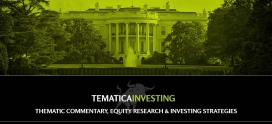The Wild Ride Continues as the East Coast Braces for ‘Snowmageddon’ 2016
Amid the volatility that has led all the major markets lower on a year-to-date basis, yesterday we saw a bit of a reprieve following comments from European Central Bank President Mario Draghi suggesting perhaps another round of stimulative monetary policy could be in the cards. Perhaps he had a preview of this morning’s Eurozone Flash Composite PMI report for January, which hit an 11-month low with declines in both manufacturing and services orders.
Additionally, one of the main drivers of the stock market of late — falling oil prices — recovered a bit yesterday. The move higher in oil prices reflects a smaller inventory build per today’s Energy Information Administration (EIA) report, as compared with the American Petroleum Institute’s previous report. Peering into that EIA report, however, U.S. crude oil inventories are at levels not seen in the last 80 years. While oil prices probably will trend higher near term as the East Coast gets hit with a massive snowstorm this weekend, with U.S. refineries still clocking in at 90.6% capacity utilization and crude oil imports up year over year, I expect the recent oil price bump could be short lived amid the slowing global economy.
This morning’s December read on the Chicago Fed’s National Activity Index marked the fifth consecutive month of contracting national activity in the United States. To me, that adds to the concern raised by the January Empire Manufacturing Report that was published last week and showed “that business activity declined for New York manufacturers at the fastest pace since the Great Recession.” Digging into that report, new orders, shipments and overall business conditions fell sharply during the month. That weakening outlook was reiterated this week in the January Philly Fed Index, which not only remained in contraction territory, but also showed yet another drop in its six-month outlook indicator — down to 19.1 from 24.1 in December and 43.4 in November.
Against that backdrop, it’s not hard to see how in its December earnings report this morning, General Electric’s ([stock_quote symbol=”GE”]) industrials segment posted a 1% decline in both organic profit and revenue for the quarter.
In other economic news, a rather unsurprising December Consumer Price Index report showed a deflationary environment, which I chalk up to the drop in oil and gas prices. Given the weakening economic climate and continued lack of inflationary pressures thus far in the data, there is a high probability the Federal Reserve will leave interest rates unchanged at their meeting next week (Jan. 26-27).
Amid those latest gleanings that show the domestic economy is losing ground, the velocity of earnings reports has started to pick up, and so far I have to say we’ve seen more than a fair amount of disappointing, if not flat out weaker-than-expected, outlooks from IBM ([stock_quote symbol=”IBM”]), Starbucks ([stock_quote symbol=”SBUX”]), Deutsche Bank ([stock_quote symbol=”DB”]), United Continental ([stock_quote symbol=”UAL”]), Intel ([stock_quote symbol=”INTC”]), Union Pacific ([stock_quote symbol=”UNP”]), American Express ([stock_quote symbol=”AXP”]) and others. That velocity only will accelerate further given the number of companies that will be reporting their quarterly earnings next week and the week after. In total, I count more than 1,200 companies issuing their December quarterly results in the next two weeks, with a good percentage of them updating their outlook for the coming months. It’s not all going to be peaches and cream, it probably won’t even be close, given the economic climate that is developing and other factors that are helping to ratchet up uncertainty. In such an environment, management teams tend to be cautious, if not overly so.
Turning to our Tematica Select List holdings, even after factoring in yesterday’s 0.5% move higher in the S&P 500, the index is still down some 8.6% on the year as of Thursday’s market close. That should leave us feeling pretty good with the decision to shed more growth-oriented, and therefore more volatile, positions. Granted, on Wednesday we saw what could have been our first glimmer of market capitulation as the S&P swung 63.9 points (or 3.4%), but the data — both economic and earnings — suggest we have more to go in terms of expectations being reset lower. Such volatility tells me we should continue to treat any bounce as something of the dead cat kind until we see the market gyrations settle down on a sustained basis. I suspect that, like me, you do not want to walk headlong into an unexpected frying pan to the face just because we’d like to think things have settled down even though they probably haven’t.
To me, this is time to calmly and coolly sit back and add to our thematic investing shopping list. That’s what I’ve been doing and plan on continuing to do in the coming week. In the meantime, let’s continue to keep our insurance position, the ProShares Short S&P 500 ETF ([stock_quote symbol=”SH”]), intact as it will help hedge us against additional market turbulence.
As I look over our current crop of holdings, many of which offer hefty dividend yields, I am placing our shares of American Capital Agency Corp. ([stock_quote symbol=”AGNC”]) on my watch-closely list. We enjoy a monthly $0.20 per share dividend, which equates to a staggering 15% dividend yield at the current share price, and the shares are trading near a 30% discount to book value at current levels. To me, the factor to watch will be the Fed’s language next week — if it softens a bit, and Fed Chair Janet Yellen once again touts her now infamous “data dependent” line. If she does, I suspect shares of our deeply discounted real estate investment trust will get a boost. If Yellen continues her “tough” interest rate talk, then it could be time to re-evaluate this positon.
For those of you on the East Coast, and more specifically in and around the Washington, D.C., area like me, please hunker down and stay safe this weekend. For those of you looking to generate a short-term profit from the storm, there are the obvious players, such as Home Depot ([stock_quote symbol=”HD”]) and the Utilities Sector SPDR ([stock_quote symbol=”XLU”]), that you should consider. Given our thematic investing perspective and medium-to-longer-term investing time horizon, I’m not making a formal recommendation, but I easily can see those getting a short-term boost from the storm.




